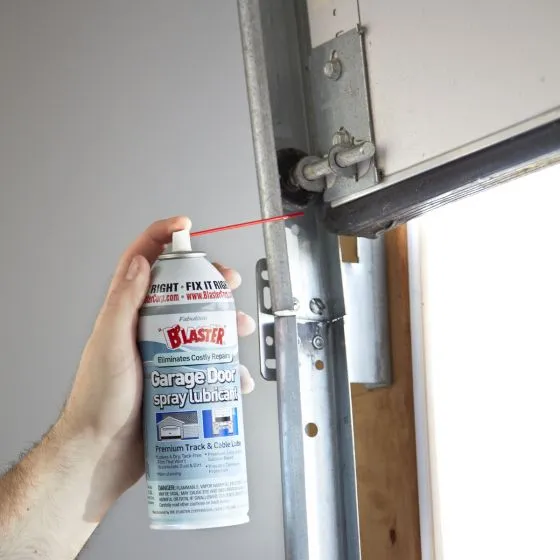Mastering Garage Door Lubrication: Your Ultimate Guide for a Silent, Smooth Operation
Going home from your work drops your stress levels right away – not until you hear garage door squeaking noises. The screeching, banging, and squeaking noises make it hard for you to relax. So you’re wondering what you should do.
If you don’t know by now, a noisy garage door is due to worn-out parts of the garage door. If you inspect them, you see rust, dirt, and dust buildup. In worst cases, they might be damaged.
Note that a squeaky garage door might lead to safety risks. If you don’t want to live with the noise, you can do something. You can silence the noise by using a garage door lubricant. Once you know how to lu can say goodbye to the garage door squeaking noises. With this in mind, these are the basic steps you can do when lubricating the garage door.
a well-lubricated garage door

A well-lubricated garage door doesn’t produce noise during the operation. There’s only minimal noise you can hear from the garage door opener. But with everything else, there’s no sound you can detect from it. Because of this, lubricating your garage door is one of the most important maintenance steps. It’s that important since it ensures that your garage door move smoothly while reducing the noise.It also helps avoid accidents by decreasing the friction between the components and parts that would come into contact.
parts that needed lubrication
Several parts of your garage door require lubrication for optimal operation. These are the parts you need to grease up:
1. Tracks
Lubricate the tracks every year. However, it’s essential to inspect them every few months to prevent dust or dirt buildup.
2. Springs
Garage door springs do all the hard work for your garage door. They move constantly, so they are prone to wearing and thinning. If they are not well-maintained, they could produce squeaks and squeals. Because of this, spray them as needed to move quickly and seamlessly.
3. Hinges
Hinges are as crucial as the rest of your garage door. If your hinges are steel-made, lubricate them at the pivot points. However, don’t try to grease if they are made of plastic.
4. Rollers
Lubricate the rollers to ensure your garage door is moving smoothly. Ensure the type of rollers you have so you know how to grease them properly.
5. Locks
Once the key sticks inside the locks, make sure to spray lubricant, especially the inner bearings.
choosing the best lubricant for your garage door
If there’s one thing, you should remember, choosing the best garage door lubricant is crucial to produce desirable results. Some of the recommended lubricants are silicone-based and white lithium sprays – which we will discuss further below.
SILICONE-BASED LUBRICANTS
Silicone sprays are some of the products to use when it comes to lubricating your garage door. They are equipped with thin nozzle sprays to make it easy to get into the inner working of the parts. You don’t need to worry about over-applying with silicone spray since it’s precise enough to target the spots. Moreover, the effects of silicone-based sprays are long-lasting. It can withstand changes in weather and temperature. Thus, it is suitable to use all year round.
WHITE LITHIUM GREASE
In contrast to silicone-based lubricants, white lithium may get your hands messy. However, you can see satisfying results when using it.It allows you complete control when you use white lithium grease, mainly when you use it on the components. Make sure to use it with your hands, and apply liberally on the springs, bearings, hinges, and rollers for an even coat. After doing it, you won’t hear any squeaking noise. White lithium is an excellent grease for garage door. However, avoid overapplying to it to prevent the accumulation of dirt and dust. Only a tiny amount goes a long way to get rid of noise and friction in the parts.
AVOID WD-40
WD-40 can be used as a garage door lube to clean the moving components’ rust, dirt, and grime. However, that’s where its purpose ends. Avoid using this because it won’t lubricate the parts that much. Always use a silicone or white lithium spray for best results.
CLEAN ALL NON-MOVING PARTS
When working with your garage, it’s essential to prevent the track from moving. Hence, it’s best to grease the garage door during colder temperatures. Another thing to consider before lubricating your garage door is to clean the parts. In this way, you’ll prevent any debris and dust from settling into the parts. Use a dry brush, towel, or broom handle when removing dirt and debris.
HOW TO LUBRICATE GARAGE DOOR?
If you’ve never lubricated garage door parts before, follow this guide for the process. Although, make sure you clean the parts beforehand to make the lubrication process easy and faster.
Here are some of the parts you need to lubricate:
1. Lubricate the Springs
Springs are under constant stress due to frequent expansion and contraction every time you use your garage door. Hence, it’s important to lubricate them before showing signs of damage. Grease the spring’s surface by using white lithium grease. In this way, you’ll apply an even coat to the springs.
2. Lubricate the Rollers
There are different ways to lubricate according to the type of rollers. For example, only apply grease to the bearings if you’re using nylon. On the other hand, apply a lubricant all over with a metal roller. However, don’t overdo it if you don’t want the grease to drip down.
3. Lubricate the Hinges
To keep the hinges smooth and functioning, apply a white lithium grease or silicone spray. However, we recommend using white lithium grease to avoid dripping on the garage door panels.
4. Lubricate the Locks
Make sure to keep the locks lubricated to prevent any frozen or sticky situations.
When dealing with locks, it’s best to use a silicone spray since its nozzle can get through the inner locking mechanisms. A quick spray of the silicone will do the work to lubricate the locking shafts. Finally, wipe any excess with a clean towel or a rag.
Test your garage door once you’re done lubricating all the parts. Open and close it a few times and make sure you don’t hear any garage door squeaking sounds.
I hope this guide helped you in lubricating your garage door. After all, it’s one of the essential maintenance tasks you can do on your own to prevent problems in the operation of your garage door.

